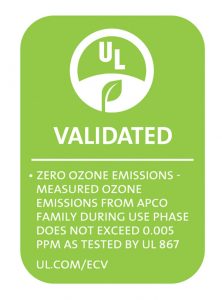
Clearing the air on ozone
December 13, 2018 | By Aaron Engel

Approved products also receive a validation badge that can be displayed on marketing materials and product labels.
Twenty years ago, consumers knew very little about indoor air quality (IAQ) and its effects on their health in the home. Subsequent media attention and contractor awareness, saw a flurry of manufacturers offering IAQ air treatment equipment for homeowners wishing to improve their IAQ. Meanwhile, contractors saw opportunities for additional business.
Contractors began installing many of these devices within HVAC systems, which offer the most effective method for distributing treated air evenly throughout the household.
IAQ manufacturers helped nurture the trend with new and innovative marketing terms promoting technologies, such as ionization, plasma, oxidation, peroxides among many others.
Unfortunately, many of these marketed air treatment technologies produce ozone, by-products of ozone and/or other reactive oxygen species (ROS). ROS, in particular ozone, has recently come under scrutiny as a source of respiratory irritation and even lung damage. Ironically, many of the actual technologies consumers were purchasing to improve IAQ can actually cause respiratory maladies the consumers were originally intending to avoid or treat.
To worsen matters, organizations such as Health Canada and the Centers for Disease Control and Prevention in Atlanta, GA report that those with the greatest risk to ozone exposure–older adults, infants and children–are the same consumers with higher incidences of asthma or other lung diseases.
As the IAQ purification marketplace became inundated with products that produced measurable ozone emissions, there was an increase in negative media attention spotlighting ozone dangers. Subsequently, manufacturers, many of which purposefully designed ozone generation into products to create ozone’s distinct odour or scent, began substituting the word “ozone” with marketing terms.
This misguided marketing created confusion in the marketplace regarding the amount of ozone generation and off-gassing being emitted by several IAQ technologies, products, and brands. Consequently, consumers and even HVAC contractors, who wanted to install the safest products, had nowhere to turn for zero ozone emission confirmation.
ENVIRONMENTAL CLAIM PROCEDURE
Underwriters Laboratories (UL) in Northbrook, IL, recently took on the task of creating the validation for zero ozone air cleaning devices. UL 2998 is the environmental claim procedure with validation.
Contractors and consumers can now visit UL SPOT (ul.com/spot), which lists all types of sustainable products worldwide, especially those that are ECOLOGO Certified, a Canadian eco-label UL recently purchased.
The UL SPOT also lists validated zero ozone products under the site search term of “HVAC Air Cleaners.” Qualifying zero ozone emission products must demonstrate they emit less than the maximum ozone concentration limit of 0.005 ppm (5 ppb) which is below quantifiable level for ozone testing. This is 10-fold less than permitted under test standard UL 867, which allows concentrations of 0.05 ppm (50 ppb).
Approved products also receive a validation badge that can be displayed on marketing materials and product labels.
EXPOSURE LIMITS
The health concerns of exposure to ozone have been gaining increased attention among many organizations in many countries. Health Canada advises against using ozone generators in homes. It recommends a residential maximum exposure limit of 40 µg/m3 (20 ppb) ozone, based on an averaging time of eight-hours.
The U.S. Food and Drug Administration (FDA) was the first to set an ozone emissions limit of 0.05 ppm (50 ppb) for all medical devices. In 2008, the California Air Resources Board (CARB) targeted ozone emissions with a state-wide regulation requiring certification of all electronic air cleaners under UL 867’s 0.05 ppm (50 ppb) limit.
Most HVAC applications that utilize UV light devices to treat surface-bound or airborne micro-organisms use the germicidal UV-C wavelength of 254 nanometers (nm), which is the most lethal for micro-organisms and is also non-ozone producing. However, some UV-systems may not only utilize UV-C, but also a secondary wavelength called UVV (or vacuum UV) at the 185 nm, This UVV wavelength produces ozone.
Ozone producing devices cannot be visibly detected and will appear similar to zero-ozone versions. Prior to UL 2998 being established as a voluntary test and validation procedure for air treatment manufacturers, contractors and wholesalers had no resources or standard methods of test for identifying true zero ozone UV disinfection air treatment systems.
INCREASED AWARENESS
Like the FDA and CARB, ASHRAE recently made known its viewpoint of ozone in its 2015 publication “Position Document on Filtration and Air Cleaning.”
The position document’s Section 2.6 states: “Ozone is harmful for health and exposure to ozone creates risk for a variety of symptoms and diseases associated with the respiratory tract; Ozone emission is thus undesirable.”
Section 3.2 of the document further states: “devices that use the reactivity of ozone for the purpose of cleaning the air should not be used in occupied spaces because of negative health effects that arise from exposure to ozone and its reaction products.”
Besides better occupant health in commercial buildings, specifying zero ozone air treatment devices also help facility owners satisfy requirements of green building design programs, codes and procurement policies including Leadership in Energy and Environmental Design, the International Green Construction Code (IgCC) and European Union guidelines and directives.
With the increased awareness regarding exposure to ozone in indoor environments contractors in the HVAC industry are poised to lessen the products that emit ozone, ozone by-products or other ROS.
Air treatment devices are an excellent add-on sale for contractors to increase profits, while also providing their customers with safe and healthy IAQ. Contractors and wholesalers should commit to products that are in their customer’s best interests and supported with UL 2998 to guard against the potential liabilities of ozone. <>
Aaron Engel is vice president of business development at Fresh-Aire UV, a North American manufacturer of residential, commercial and medical UV disinfection and carbon/titanium/PCO-based systems. Engel can be reached at aaron@freshaireuv.com.




